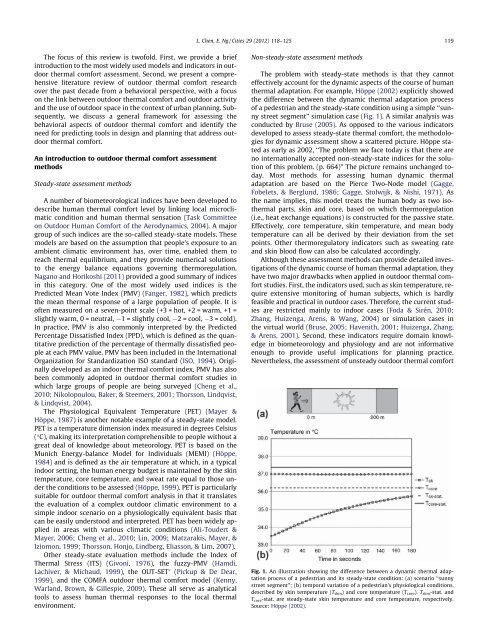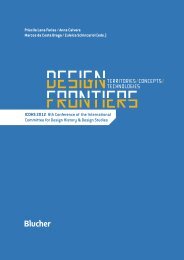Outdoor thermal comfort and outdoor activities: A review of research ...
Outdoor thermal comfort and outdoor activities: A review of research ...
Outdoor thermal comfort and outdoor activities: A review of research ...
You also want an ePaper? Increase the reach of your titles
YUMPU automatically turns print PDFs into web optimized ePapers that Google loves.
The focus <strong>of</strong> this <strong>review</strong> is tw<strong>of</strong>old. First, we provide a brief<br />
introduction to the most widely used models <strong>and</strong> indicators in <strong>outdoor</strong><br />
<strong>thermal</strong> <strong>comfort</strong> assessment. Second, we present a comprehensive<br />
literature <strong>review</strong> <strong>of</strong> <strong>outdoor</strong> <strong>thermal</strong> <strong>comfort</strong> <strong>research</strong><br />
over the past decade from a behavioral perspective, with a focus<br />
on the link between <strong>outdoor</strong> <strong>thermal</strong> <strong>comfort</strong> <strong>and</strong> <strong>outdoor</strong> activity<br />
<strong>and</strong> the use <strong>of</strong> <strong>outdoor</strong> space in the context <strong>of</strong> urban planning. Subsequently,<br />
we discuss a general framework for assessing the<br />
behavioral aspects <strong>of</strong> <strong>outdoor</strong> <strong>thermal</strong> <strong>comfort</strong> <strong>and</strong> identify the<br />
need for predicting tools in design <strong>and</strong> planning that address <strong>outdoor</strong><br />
<strong>thermal</strong> <strong>comfort</strong>.<br />
An introduction to <strong>outdoor</strong> <strong>thermal</strong> <strong>comfort</strong> assessment<br />
methods<br />
Steady-state assessment methods<br />
A number <strong>of</strong> biometeorological indices have been developed to<br />
describe human <strong>thermal</strong> <strong>comfort</strong> level by linking local microclimatic<br />
condition <strong>and</strong> human <strong>thermal</strong> sensation (Task Committee<br />
on <strong>Outdoor</strong> Human Comfort <strong>of</strong> the Aerodynamics, 2004). A major<br />
group <strong>of</strong> such indices are the so-called steady-state models. These<br />
models are based on the assumption that people’s exposure to an<br />
ambient climatic environment has, over time, enabled them to<br />
reach <strong>thermal</strong> equilibrium, <strong>and</strong> they provide numerical solutions<br />
to the energy balance equations governing thermoregulation.<br />
Nagano <strong>and</strong> Horikoshi (2011) provided a good summary <strong>of</strong> indices<br />
in this category. One <strong>of</strong> the most widely used indices is the<br />
Predicted Mean Vote Index (PMV) (Fanger, 1982), which predicts<br />
the mean <strong>thermal</strong> response <strong>of</strong> a large population <strong>of</strong> people. It is<br />
<strong>of</strong>ten measured on a seven-point scale (+3 = hot, +2 = warm, +1 =<br />
slightly warm, 0 = neutral, 1 = slightly cool, 2 = cool, 3 = cold).<br />
In practice, PMV is also commonly interpreted by the Predicted<br />
Percentage Dissatisfied Index (PPD), which is defined as the quantitative<br />
prediction <strong>of</strong> the percentage <strong>of</strong> <strong>thermal</strong>ly dissatisfied people<br />
at each PMV value. PMV has been included in the International<br />
Organization for St<strong>and</strong>ardization ISO st<strong>and</strong>ard (ISO, 1994). Originally<br />
developed as an indoor <strong>thermal</strong> <strong>comfort</strong> index, PMV has also<br />
been commonly adopted in <strong>outdoor</strong> <strong>thermal</strong> <strong>comfort</strong> studies in<br />
which large groups <strong>of</strong> people are being surveyed (Cheng et al.,<br />
2010; Nikolopoulou, Baker, & Steemers, 2001; Thorsson, Lindqvist,<br />
& Lindqvist, 2004).<br />
The Physiological Equivalent Temperature (PET) (Mayer &<br />
Höppe, 1987) is another notable example <strong>of</strong> a steady-state model.<br />
PET is a temperature dimension index measured in degrees Celsius<br />
(°C), making its interpretation comprehensible to people without a<br />
great deal <strong>of</strong> knowledge about meteorology. PET is based on the<br />
Munich Energy-balance Model for Individuals (MEMI) (Höppe,<br />
1984) <strong>and</strong> is defined as the air temperature at which, in a typical<br />
indoor setting, the human energy budget is maintained by the skin<br />
temperature, core temperature, <strong>and</strong> sweat rate equal to those under<br />
the conditions to be assessed (Höppe, 1999). PET is particularly<br />
suitable for <strong>outdoor</strong> <strong>thermal</strong> <strong>comfort</strong> analysis in that it translates<br />
the evaluation <strong>of</strong> a complex <strong>outdoor</strong> climatic environment to a<br />
simple indoor scenario on a physiologically equivalent basis that<br />
can be easily understood <strong>and</strong> interpreted. PET has been widely applied<br />
in areas with various climatic conditions (Ali-Toudert &<br />
Mayer, 2006; Cheng et al., 2010; Lin, 2009; Matzarakis, Mayer, &<br />
Iziomon, 1999; Thorsson, Honjo, Lindberg, Eliasson, & Lim, 2007).<br />
Other steady-state evaluation methods include the Index <strong>of</strong><br />
Thermal Stress (ITS) (Givoni, 1976), the fuzzy-PMV (Hamdi,<br />
Lachiver, & Michaud, 1999), the OUT-SET (Pickup & De Dear,<br />
1999), <strong>and</strong> the COMFA <strong>outdoor</strong> <strong>thermal</strong> <strong>comfort</strong> model (Kenny,<br />
Warl<strong>and</strong>, Brown, & Gillespie, 2009). These all serve as analytical<br />
tools to assess human <strong>thermal</strong> responses to the local <strong>thermal</strong><br />
environment.<br />
L. Chen, E. Ng / Cities 29 (2012) 118–125 119<br />
Non-steady-state assessment methods<br />
The problem with steady-state methods is that they cannot<br />
effectively account for the dynamic aspects <strong>of</strong> the course <strong>of</strong> human<br />
<strong>thermal</strong> adaptation. For example, Höppe (2002) explicitly showed<br />
the difference between the dynamic <strong>thermal</strong> adaptation process<br />
<strong>of</strong> a pedestrian <strong>and</strong> the steady-state condition using a simple ‘‘sunny<br />
street segment’’ simulation case (Fig. 1). A similar analysis was<br />
conducted by Bruse (2005). As opposed to the various indicators<br />
developed to assess steady-state <strong>thermal</strong> <strong>comfort</strong>, the methodologies<br />
for dynamic assessment show a scattered picture. Höppe stated<br />
as early as 2002, ‘‘The problem we face today is that there are<br />
no internationally accepted non-steady-state indices for the solution<br />
<strong>of</strong> this problem. (p. 664)’’ The picture remains unchanged today.<br />
Most methods for assessing human dynamic <strong>thermal</strong><br />
adaptation are based on the Pierce Two-Node model (Gagge,<br />
Fobelets, & Berglund, 1986; Gagge, Stolwijk, & Nishi, 1971). As<br />
the name implies, this model treats the human body as two iso<strong>thermal</strong><br />
parts, skin <strong>and</strong> core, based on which thermoregulation<br />
(i.e., heat exchange equations) is constructed for the passive state.<br />
Effectively, core temperature, skin temperature, <strong>and</strong> mean body<br />
temperature can all be derived by their deviation from the set<br />
points. Other thermoregulatory indicators such as sweating rate<br />
<strong>and</strong> skin blood flow can also be calculated accordingly.<br />
Although these assessment methods can provide detailed investigations<br />
<strong>of</strong> the dynamic course <strong>of</strong> human <strong>thermal</strong> adaptation, they<br />
have two major drawbacks when applied in <strong>outdoor</strong> <strong>thermal</strong> <strong>comfort</strong><br />
studies. First, the indicators used, such as skin temperature, require<br />
extensive monitoring <strong>of</strong> human subjects, which is hardly<br />
feasible <strong>and</strong> practical in <strong>outdoor</strong> cases. Therefore, the current studies<br />
are restricted mainly to indoor cases (Foda & Sirén, 2010;<br />
Zhang, Huizenga, Arens, & Wang, 2004) or simulation cases in<br />
the virtual world (Bruse, 2005; Havenith, 2001; Huizenga, Zhang,<br />
& Arens, 2001). Second, these indicators require domain knowledge<br />
in biometeorology <strong>and</strong> physiology <strong>and</strong> are not informative<br />
enough to provide useful implications for planning practice.<br />
Nevertheless, the assessment <strong>of</strong> unsteady <strong>outdoor</strong> <strong>thermal</strong> <strong>comfort</strong><br />
Fig. 1. An illustration showing the difference between a dynamic <strong>thermal</strong> adaptation<br />
process <strong>of</strong> a pedestrian <strong>and</strong> its steady-state condition: (a) scenario ‘‘sunny<br />
street segment’’; (b) temporal variation <strong>of</strong> a pedestrian’s physiological conditions,<br />
described by skin temperature (Tskin) <strong>and</strong> core temperature (Tcore). Tskin-stat. <strong>and</strong><br />
T core-stat. are steady-state skin temperature <strong>and</strong> core temperature, respectively.<br />
Source: Höppe (2002).
















